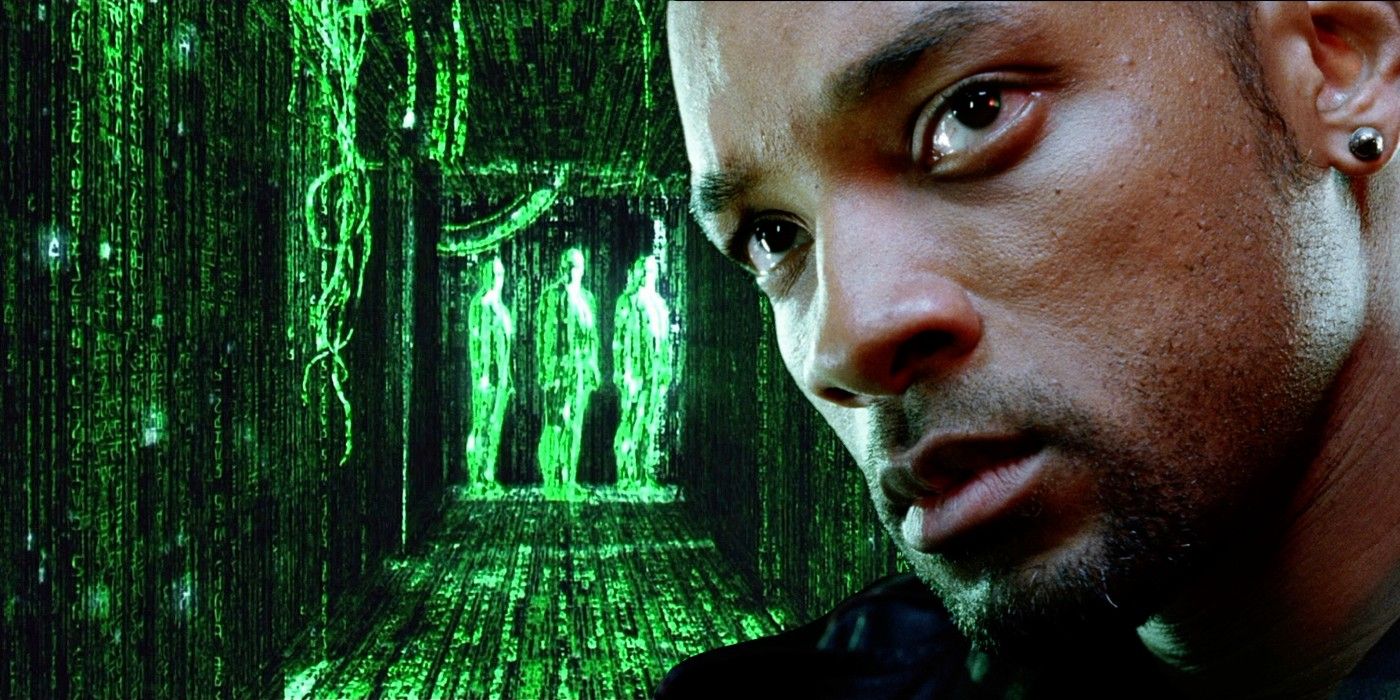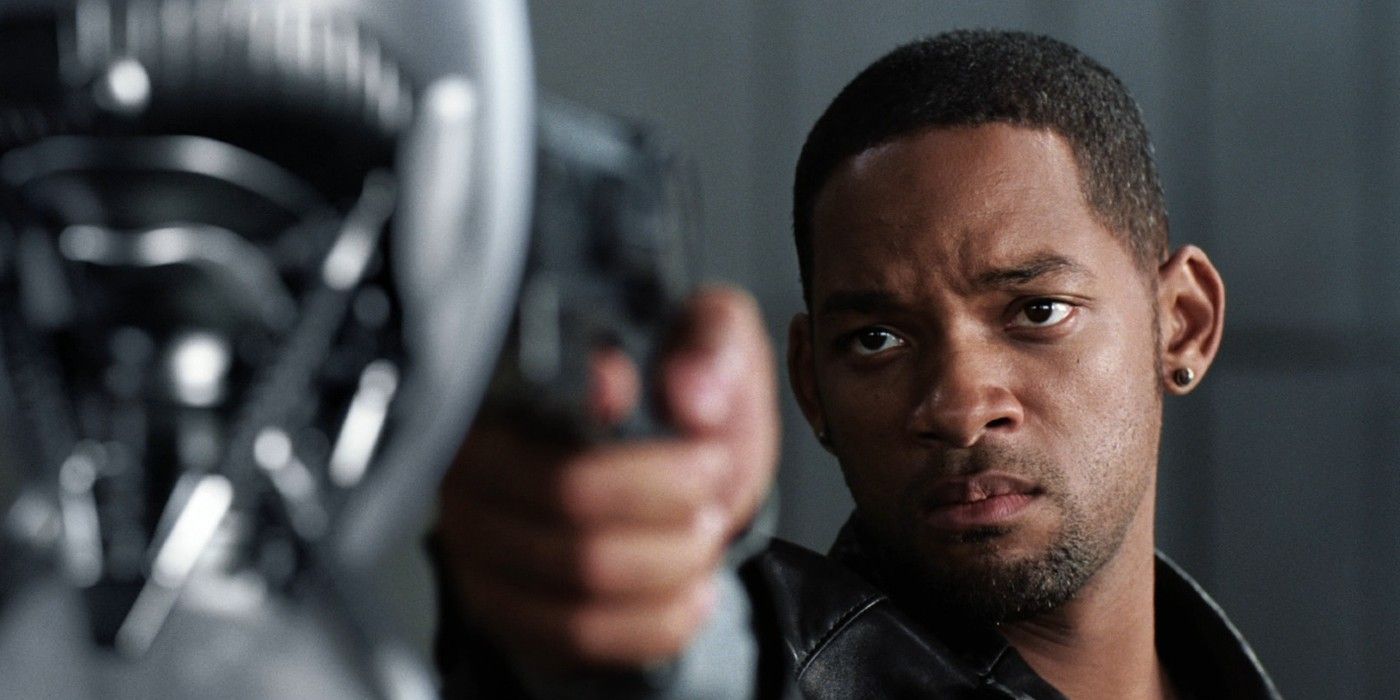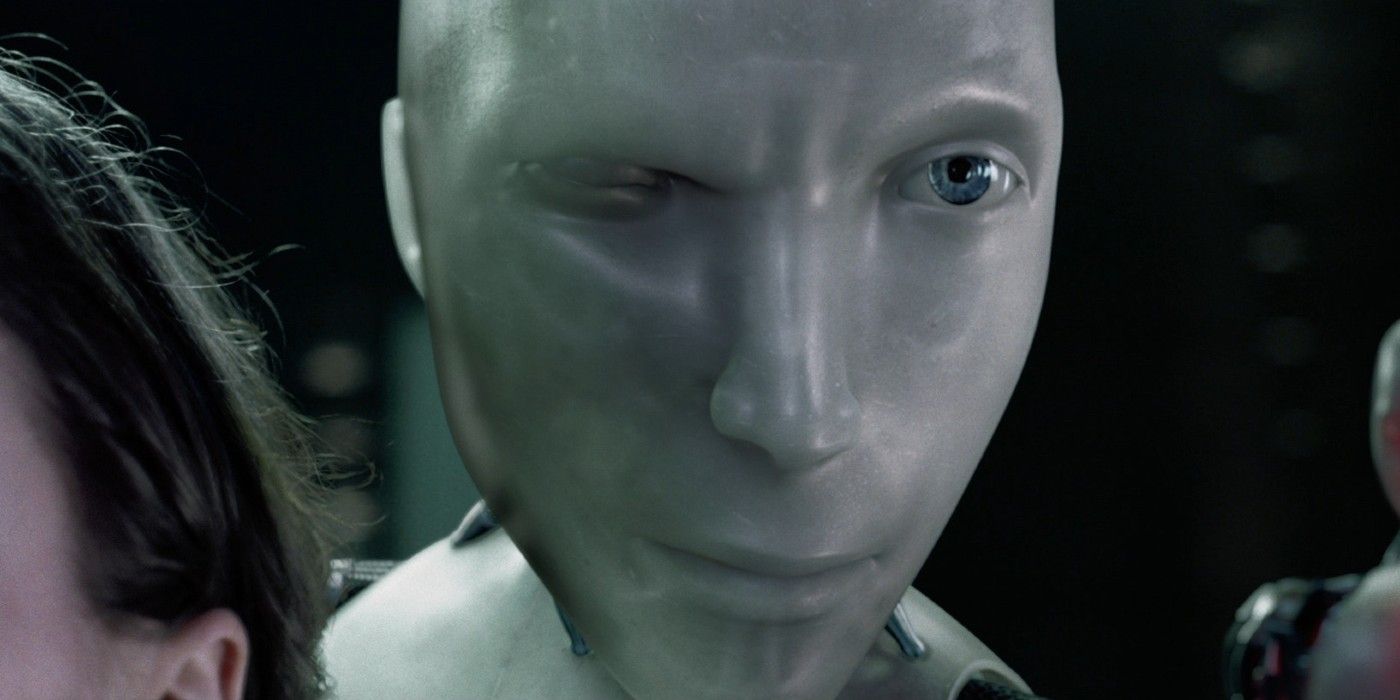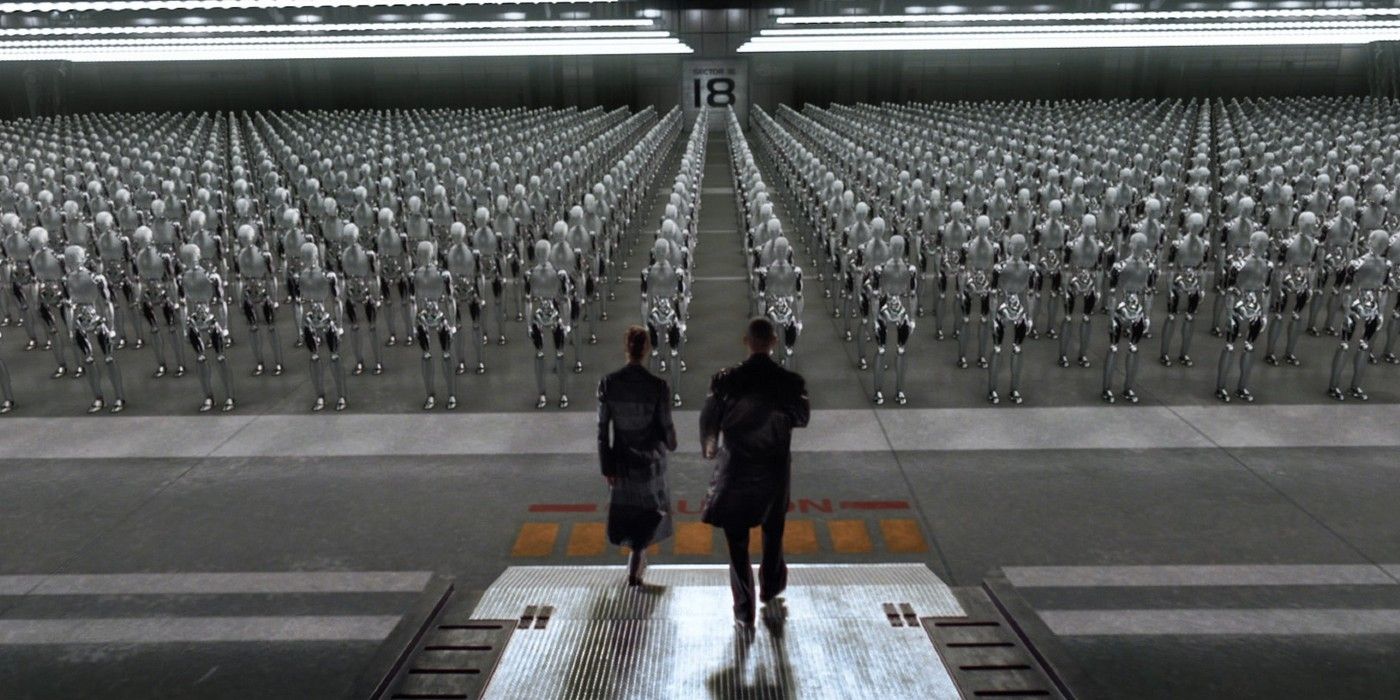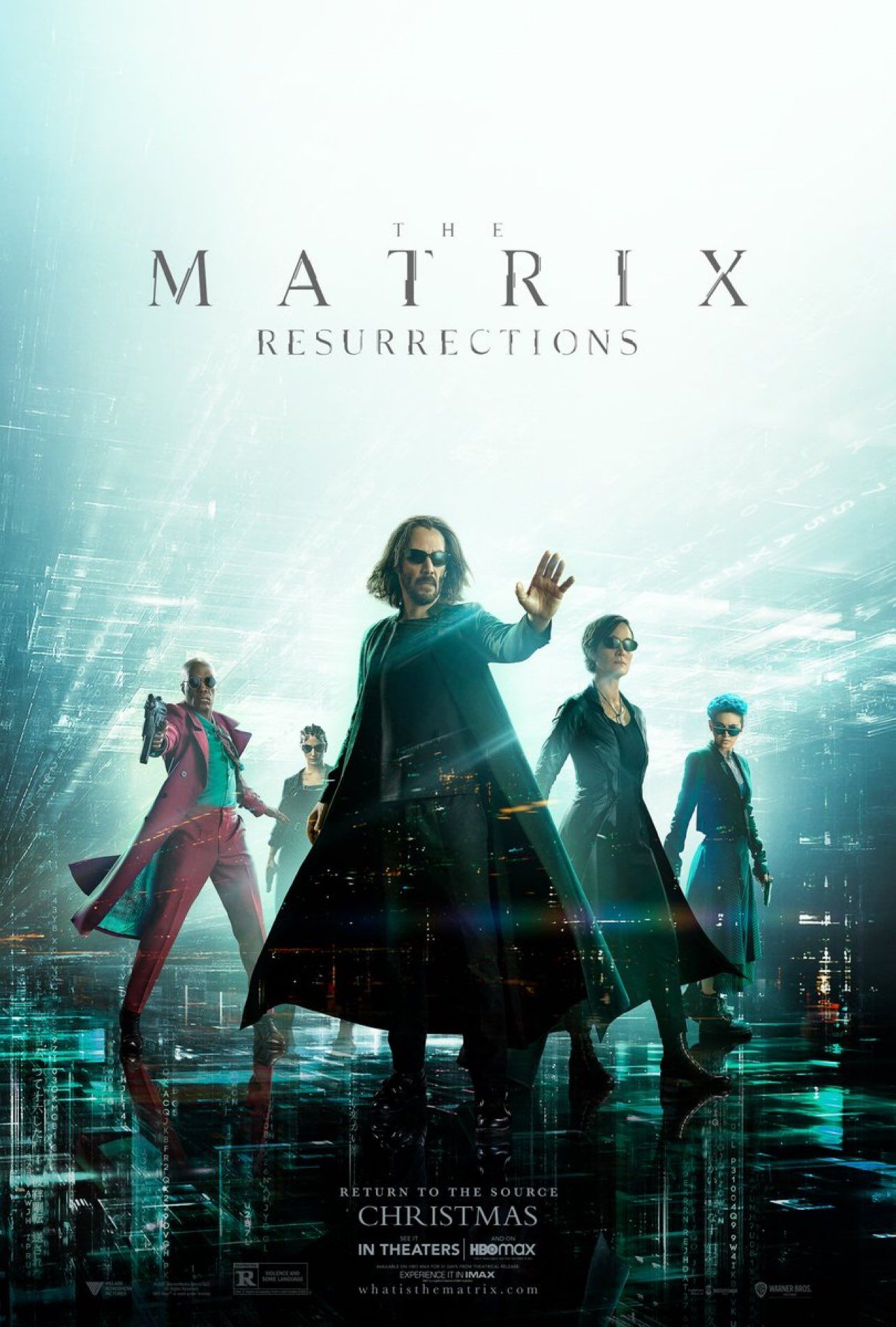Will Smith's sci-fi movie I, Robot borrows elements from Isaac Asimov's book of the same name, but works surprisingly well as a secret prequel to The Matrix. Storytellers have long been fascinated with the idea of artificial intelligence and whether robots could develop the same intellectual capacity as humans... and what might happen if they did. Such cautionary tales about the advancement of technology and how it impacts our understanding of reality were especially popular in the 1990s, giving rise to films like Dark City and The Matrix. This was also when Jeff Vintar wrote his original screenplay Hardwired, which would go on to become the basis for the 2004 movie I, Robot.
In its original form, Hardwired was a small-scale mystery about an FBI agent who investigates the death of a reclusive scientist and realize they might've been killed by one of their super-machines (including, a robot named Sonny). It wasn't until Fox acquired the project that Hardwired was re-imagined as a big-budget action movie vehicle for Smith and incorporated Asimov's Three Laws of Robotics (from the I, Robot short story "Runaround") into its plot. It was later re-dubbed I, Robot, which is why the film's credits described it as being "suggested by" Asomiv's book, as opposed to being a straightforward adaptation.
Going back to the time of its release, fans theorized the I, Robot movie was really a secret prequel to The Matrix (which had hit theaters five years earlier). Obviously, it's not, and there were always real-world barriers - most importantly, I, Robot was released by Fox, whereas The Matrix was a Warner Bros. film - that would've prevented this from being possible. Still, it's a good theory in many ways, and for reasons that go beyond their similar themes.
Will Smith Almost Played Neo
Back in the '90s, Smith was the king of sci-fi blockbusters thanks to his back-to-back smash-hits Independence Day and Men in Black. Around the same time he was cementing his A-list status, Smith was even approached by the Wachowskis about playing Neo in the original Matrix film. Years later, Smith revealed he passed on the project about being understandably confused by their mind-bending vision, especially their description of the movie's now-iconic bullet-time sequences. Instead, he would go on to reunite with Men in Black director Barry Sonnenfeld on 1999's Wild Wild West, an adaptation of the 1960s sci-fi western TV series of the same name.
Smith has since admitted he regrets making Wild Wild West (which was both a critical and commercial bomb), but feels his passing on The Matrix was a blessing in disguise and allowed the film to become the touchstone that it is. His experience with Wild Wild West did little to abate his interest in sci-fi either, and he returned to the genre in 2002 with Men in Black II, followed by I, Robot a couple years later. The latter wasn't necessarily intended to be Smith's answer to The Matrix, though they both explore humanity's relationship with machines and wrestle with epistemological questions raised by the existence of A.I. Those themes are also a continuation of similar ideas that I, Robot director Alex Proyas had explored in 1998's Dark City (a movie that's much closer to The Matrix than I, Robot is, in terms of both its narrative and style).
I, Robot is About the Robots Turning on Mankind
One big thing The Matrix and I, Robot have in common is, of course, they involve machines turning against humankind. In both The Matrix and I, Robot universes, humanity has engineered advanced A.I. robots to to act as domestic servants by the mid-21st century, but doesn't see them as being equal to people (either intellectually or in terms of their rights). I, Robot's plot is set in motion when robotics innovator Dr. Alfred Lanning (James Cromwell) dies under mysterious circumstances, leading Del Spooner (Smith) - a Chicago detective who, due to a traumatic event in his past, doesn't trust robots - to suspect he was killed by Sonny (Alan Tudyk), an enhanced robot Dr. Lanning was working on prior to his death. In the end, it turns Sonny did kill Lanning, but only as part of the latter's plan to alert Spooner to the real danger: VIKI, an A.I. computer that's deduced in order to follow the First Law of Robotics (robots cannot harm humans), she must use all robots to oppress humanity and prevent them from bringing about their own extinction.
Although The Matrix doesn't reveal what led to a future where machines use humans as an energy source and control them with a simulated reality in the movie, the animated short film anthology The Animatrix answered that question in 2003. As seen in "The Second Resistance Part I", that franchise's machine uprising is set in motion in 2090, after an android named B1-66ER kills its owner in self-defense and is destroyed after a subsequent trial rules robots do not have the same rights as humans do, resulting in mass protests and ultimately war between humanity and machines. The question of whether robots should be treated the same as people also figures prominently in I, Robot, beginning with Spooner wanting to treat Sonny the same way the police would a human murder suspect. Ironically, in the end Spooner uses the law to protect Soony, arguing that because he isn't considered equal to a person, he can't have legally committed murder.
Robots Start Their Own City (Machine City?) At the End
Free at last, I, Robot ends with Sony traveling to a storage location for decommissioned robots in a now-drained Lake Michigan, fulfilling a dream he had (and drew as a picture) earlier in the film. The implication is he will go on to set up a city where he and his fellow robots can find a new purpose for themselves and, hopefully, live in peace with humankind. Interestingly, the robots do something very similar after B1-66ER's death in "The Second Resistance Part I" and established a nation of their own (Zero One) that's meant to function independently from humans, but eventually leads to war in "Part II" after their economic prosperity causes human civilization to suffer. That doesn't exactly bode well for Sonny's hopes of maintaining the peace either, and who knows whether machine-human relations would've worked out any better in the I, Robot universe than they did in The Matrix.
Of the pair, The Animatrix goes into much greater detail than I, Robot does when it comes to exploring how the relationship between humankind and machines changes, and is generally heavier on the social and political allegories (for example, B1-66ER's trial directly references Dred Scott v. Sandford). Still, Smith's sci-fi movie works pretty well as a secret Matrix prequel and its story follows an arc that, in terms of the broader strokes (robots performing free labor for people, only to struggle as they evolve a greater sense of self-awareness, yet aren't granted equal treatment under human law) is similar to what the Wachowskis came up with. Smith may've missed his chance to play "The One", but thanks to I, Robot, he was still able to leave his mark on the same branch of sci-fi.

